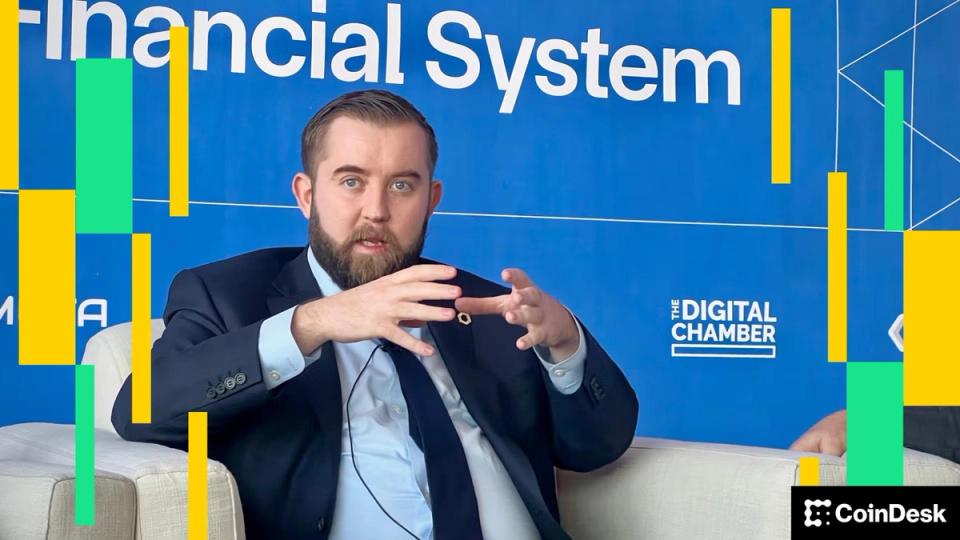The Moses-Saunders Power Dam, located between Canada and New York State, regulates the level of a river that flows from the Great Lakes to the Atlantic Ocean.
The 65-year-old structure also supports two hydroelectric power stations and a steady source of cheap, debt-free energy.
No wonder Bitcoin miners fell in love with it.
“The facility we use is a stone’s throw away from the dam,” Rob Chang, the CEO of Gryphon Digital Mining, told DL News.
Stay ahead of the game with our weekly newsletters
“In addition, we bought carbon offset credits a few years ago,” he said. “We don’t need to [the credits] for our base-level operations, because our miners used hydro-power, so it’s zero emissions.”
“We were easy to target — the greedy Bitcoin miners who are destroying the world by using coal power for their machines.”
—Rob Chang
Gryphon says it is a carbon negative Bitcoin mining company, meaning it removes more carbon from the atmosphere than it emits.
It is at the forefront of a push to make Bitcoin mining compliant with ESG, an investment approach that stands for environmental, social and governance criteria. ESG-observant companies tend to attract more investors, greater value and better financing.
Read now
A 2022 study by Deloitte found that companies that improve their ESG performance can boost a key pre-tax earnings measure by 1.8 times.
Join the community to get our latest stories and updates
Wall Street firms also subscribe to the ESG approach and offer dozens of funds with ESG brands. A Bitcoin mining outfit with solid ESG credentials can draw a lot of favor with those types of money managers, especially in a bull market.
Investment giants BlackRock and Fidelity are keen to launch their own Bitcoin exchange-traded funds and make the digital asset a more mainstream offering.
Additionally, Gryphon is set to go public as part of a merger with Akerna, a Nasdaq-listed cannabis software firm in Denver.
The so-called reverse merger means that Gryphon gets access to Akerna’s Nasdaq listing, which helps the young firm attract capital from US investors.
Climate destroying sticks
But there’s another reason behind the green push: Bitcoin miners are sick and tired of being portrayed as climate-destroying stooges.
“It’s always fun to stand with some villain,” Chang said. “We were easy to target – the greedy Bitcoin miners who are destroying the world using coal power for their machines.”
US Bitcoin miners have caused as much carbon pollution as 3.5 million gasoline-powered cars, The New York Times reported in April.
Read now
:quality(70)/cloudfront-eu-central-1.images.arcpublishing.com/dlnews/Q53KJ6GWJZHSPDA5LIQQSKBX4Q.jpg)
Meanwhile, a United Nations think tank found in October that a forest the size of Denmark would need to be planted to offset Bitcoin mining’s carbon emissions from January 2020 to December 2021.
Bitcoin miners “probably fear being called out – rightly – for consuming more electricity than the entire traditional financial system combined, while not returning even the tiniest fraction of the same level of utility,” Alex de Vries, a data scientist and financial economic crime expert at De Nederlandsche Bank in Amsterdam, told DL News.
Read now
:quality(70)/cloudfront-eu-central-1.images.arcpublishing.com/dlnews/ZOLRRKUDKVD5NFG6JJNWDDK2VQ.jpg)
Decarbonizing Bitcoin mining will not be easy, nor will it meet the complicated requirements of ESG.
Over the past decade, companies and investment firms have struggled to find useful ways to measure ESG compliance. Unlike finance, where Generally Accepted Accounting Principles, or GAAP, puts everyone on the same page, ESG investing has no industry standard.
Bare glance
Yet Bitcoin miners like Gryphon are turning to independent organizations and global consulting firms to audit and certify their ESG efforts.
The idea is to reassure investors, and regulators, that they are indeed limiting greenhouse gas emissions.
How Gryphon is doing offers a rare look at an issue that is sure to become more important as Bitcoin recovers and more investors jump into the crypto market.
Read now
:quality(70)/cloudfront-eu-central-1.images.arcpublishing.com/dlnews/TWPU7JL6QNHKTHFTCYGPQTBTJY.jpg)
Founded in 2020 by Chang and Dan Tolhurst, Gryphon quickly assembled a seasoned team of executives from some of the largest Bitcoin mining operations in the US.
The company’s CFO, Sim Salzman, previously held the same role at Marathon Digital Holdings, a listed mining company with a market capitalization of $5.8 billion.
Chris Ensey, Gryphon’s chief technical advisor, is the former CEO of Riot Platforms, another industry leader.
And Chang previously served as CFO at Riot and as a managing director at Cantor Fitzgerald, the 79-year-old trading and financial services firm.
From the beginning, Gryphon was designed to have a zero carbon footprint.
In a filing with the US Securities and Exchange Commission in 2021, Gryphon said it would not even “consider” mining Bitcoin with energy that is not 100% renewable.
Read now
:quality(70)/cloudfront-eu-central-1.images.arcpublishing.com/dlnews/VIWNMRDPEBCRVPS7FPCTB6WB34.jpg)
“Gryphon’s mission is to create the world’s largest fully integrated pure-play Bitcoin miner with a zero carbon footprint,” it told the SEC.
Unlike older players like Marathon and Riot, Gryphon is still a small outfit. It performs 1.2 so-called exahash per second of computing power – about 20 times less than Marathon.
The more hashes an operation can perform, the more chances it has to create a block and be rewarded with Bitcoins. One exahash is equal to one quintillion hashes per second.
Reverse takeover
Gryphon wants to join the big leagues. It told the SEC that it plans to become “one of the largest renewable energy-powered data centers in the world.”
An important stepping stone is revealed by its reverse takeover of Akerna, a publicly traded marijuana company. Chang hopes the deal will close early this year.
Read now
:quality(70)/cloudfront-eu-central-1.images.arcpublishing.com/dlnews/6SDKG6UFRNFIDGTHFOLMUGSV5E.jpg)
The centerpiece of his strategy was carbon-free power, and with its constant flow of water and hydroelectric plants, Moses-Saunders was the right fit.
In 2021, Gryphon secured an agreement for the electricity. It also began purchasing carbon credits, which allow holders to emit greenhouse gases without counting the emissions as part of their footprint.
The company applies those credits to offset emissions from stock deliveries or travel to conferences.
Marathon’s view
Gryphon isn’t the only Bitcoin mining company interested in going green. Marathon claims to be 100% carbon neutral, with 58% of its energy drawn from sustainable sources.
“Marathon has become a strategic collaborator in optimizing energy utilization – both in the renewable, green energy and waste energy categories,” Marathon’s Chief Growth Officer Adam Swick told DL News.
Other public miners have comparable figures. Cleanspark claimed in its 2023 ESG report that it uses 94% clean energy across four mine sites. The firm also participates in renewable energy programs like Georgia Simple Solar to make a difference.
Read now
:quality(70)/cloudfront-eu-central-1.images.arcpublishing.com/dlnews/FOXLUPYTSBFWVC4MLNQWZ4KKB4.jpg)
Meanwhile, Bitdeer told DL News that three of its mining data centers — two in Norway, one in Washington state — were 100% carbon-free, while its data centers in Tennessee and Texas were 60% and 46% carbon-free, respectively. .
These numbers are self-reported, Bitdeer told DL News, meaning they have not been verified by a third party.
This is a common problem in the industry, Chang said.
No industry standard
Because the industry is so new—and the emphasis on using renewable energy so recent—there is no set standard for measuring a Bitcoin miner’s carbon emissions or renewable energy consumption.
Some public companies, such as CleanSpark or Hut 8, issue their own ESG reports. Others, like Marathon, collect the data internally and provide it upon request.
Canadian mining company Hut 8 told DL News its own ESG figures received third-party assurance from global accounting firm EY.
Read now
:quality(70)/cloudfront-eu-central-1.images.arcpublishing.com/dlnews/B3JFDT3625CSJDQTJF7XNKMGUA.jpg)
Erin Dermer, Hut 8’s senior vice president of communications and culture, said that nearly 72% of the firm’s high-performance computing relies on renewable energy, but only 4.6% of its mining operations did the same.
However, 40% of Hut 8’s total emissions were offset by renewable energy certificates and carbon credits in 2022.
EY noted in the firm’s ESG report that the absence of an established practice for Bitcoin mining carbon emission estimates opened up the possibility for different evaluation techniques, each with their own distinctive results.
Green evidence for Bitcoin
Chang pointed to Green Proofs for Bitcoin, an initiative led by non-profit organization Energy Web that issues ESG certificates to miners.
The nonprofit, which launched in May, looks at two metrics when evaluating miners’ sustainability efforts: how much a mining company relies on renewable energy, and how much the miner contributes to grid stability through demand programs.
According to the site, five Bitcoin mining companies, including Gryphon, Argo Blockchain and DMG Blockchain Solutions, have received certificates for their 2021 and 2022 releases.
Read now
:quality(70)/cloudfront-eu-central-1.images.arcpublishing.com/dlnews/KKRMBRQ6X5BFZIKITESSPQFJAI.jpg)
Only the certificates for DMG have been published with energy use data. Green Proofs for Bitcoin awarded the company a 96% clean energy score.
Asked if the certificate helped attract more investors, Chang said Gryphon had not needed to raise capital since late 2021 – long before the firm received the Green Proofs certificate.
“It may take some time to reap direct economic benefits as this type of certification is new, and there is still a lot of work to be done so that green miners are economically compensated for their contribution to global decarbonization efforts,” DMG Chief Operating Officer Steven Eliscu told DL News said.
Read now
:quality(70)/cloudfront-eu-central-1.images.arcpublishing.com/dlnews/XIFIKNTJ6ZA6LO3RE6HWHYXQMQ.jpg)
For all Gryphon’s efforts, it remains to be seen whether Chang and his team can scale up without relying on fossil fuels or losing efficiency.
While the Moses-Saunders facility still has room to grow, Chang is keeping an eye on other power sources in the US, Iceland or Greenland.
His two criteria: safe jurisdictions with proper rule of law, and consistent clean energy.
“We can go for the standard mix — solar, wind, geothermal. Hydro is usually the best,” Chang said. “But I’d be happy to find a nuclear plant because it’s going to be just as good as hydro.”
Tom Carreras is a market correspondent at DL News. Do you have a tip on sustainability and Bitcoin mining? Reach out to [email protected]
Disclaimer for Uncirculars, with a Touch of Personality:
While we love diving into the exciting world of crypto here at Uncirculars, remember that this post, and all our content, is purely for your information and exploration. Think of it as your crypto compass, pointing you in the right direction to do your own research and make informed decisions.
No legal, tax, investment, or financial advice should be inferred from these pixels. We’re not fortune tellers or stockbrokers, just passionate crypto enthusiasts sharing our knowledge.
And just like that rollercoaster ride in your favorite DeFi protocol, past performance isn’t a guarantee of future thrills. The value of crypto assets can be as unpredictable as a moon landing, so buckle up and do your due diligence before taking the plunge.
Ultimately, any crypto adventure you embark on is yours alone. We’re just happy to be your crypto companion, cheering you on from the sidelines (and maybe sharing some snacks along the way). So research, explore, and remember, with a little knowledge and a lot of curiosity, you can navigate the crypto cosmos like a pro!
UnCirculars – Cutting through the noise, delivering unbiased crypto news

:quality(70)/cloudfront-eu-central-1.images.arcpublishing.com/dlnews/ZFEXW7SJHNCERMXDMHMJ34BLKU.jpg)





